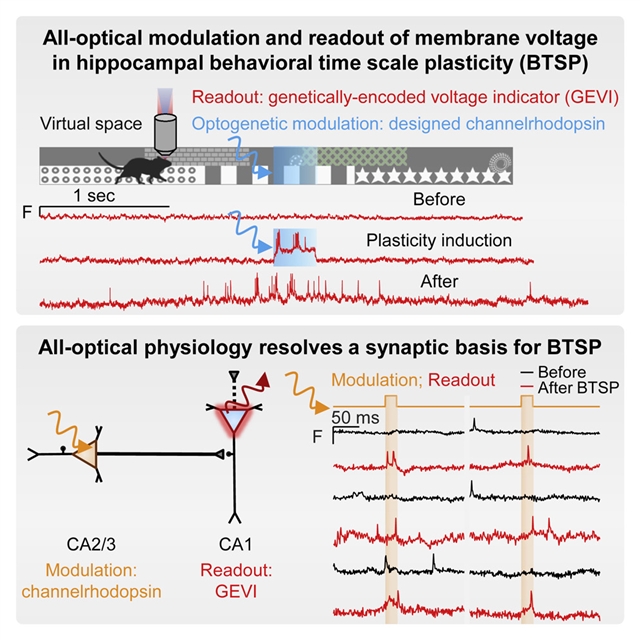
美国斯坦福大学Karl Deisseroth课题组发现,全光生理可以解析行为时间尺度可塑性的突触基础。2023年1月19日,国际知名学术期刊《细胞》在线发表了这一成果。
研究人员将基因定向电压成像与突触前和突触后神经元的定向光遗传学激活和沉默相结合,揭示了海马行为时间尺度可塑性的机制。在小鼠导航的虚拟现实环境中,对特定地点的单个CA1细胞进行有针对性的光遗传学激活,诱发了目标细胞对这些地点的稳定表述。对行为小鼠突触传递的光学诱导、记录和调制显示,突触前CA2/3细胞的活动是诱导CA1可塑性所需的,此外,在诱导单个CA1细胞的这些位置区域时,来自CA2/3细胞对这些相同细胞的突触输入被增强。这些结果揭示了海马行为时间尺度可塑性的突触行为,并确定了一种方法来解析行为哺乳动物中学习和记忆期间的突触可塑性。
据了解,学习与突触和电路特性的修改有关,但在哺乳动物中存储信息的确切变化在很大程度上仍不清楚。
附:英文原文
Title: All-optical physiology resolves a synaptic basis for behavioral timescale plasticity
Author: Linlin Z. Fan, Doo Kyung Kim, Joshua H. Jennings, He Tian, Peter Y. Wang, Charu Ramakrishnan, Sawyer Randles, Yanjun Sun, Elina Thadhani, Yoon Seok Kim, Sean Quirin, Lisa Giocomo, Adam E. Cohen, Karl Deisseroth
Issue&Volume: 2023-01-19
Abstract: Learning has been associated with modifications of synaptic and circuit properties, but the precise changes storing information in mammals have remained largely unclear. We combined genetically targeted voltage imaging with targeted optogenetic activation and silencing of pre- and post-synaptic neurons to study the mechanisms underlying hippocampal behavioral timescale plasticity. In mice navigating a virtual-reality environment, targeted optogenetic activation of individual CA1 cells at specific places induced stable representations of these places in the targeted cells. Optical elicitation, recording, and modulation of synaptic transmission in behaving mice revealed that activity in presynaptic CA2/3 cells was required for the induction of plasticity in CA1 and, furthermore, that during induction of these place fields in single CA1 cells, synaptic input from CA2/3 onto these same cells was potentiated. These results reveal synaptic implementation of hippocampal behavioral timescale plasticity and define a methodology to resolve synaptic plasticity during learning and memory in behaving mammals.
DOI: 10.1016/j.cell.2022.12.035
Source: https://www.cell.com/cell/fulltext/S0092-8674(22)01578-1
